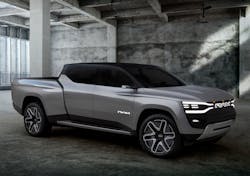Stellantis Secures Manganese Supply Deal for EV Batteries
Stellantis N.V. has agreed to buy from Australian company Element 25 Ltd. manganese sulfate monohydrate for electric vehicle battery packs as part of the global auto maker’s massive electrification push. Manganese is a key component in stabilizing the batteries.
The five-year agreement includes an equity investment of undisclosed size by Stellantis and will have shipments begin in 2026. The undertaking will require Element 25 to source material from a project in Western Australia, and the company’s leaders also plan to construct a U.S. processing facility. Last year's Inflation Reduction Act included large tax credits for people who buy EVs with batteries made in America, so shoring up the U.S. supply chain could give Stellantis vehicles greater access to those.
This move is the latest step in Stellantis’ environmentally conscious Dare Forward 2030 plan announced last March and which CEO Carlos Tavares during his recent CES2023 keynote called “our blueprint for providing cutting-edge freedom of mobility.” The goal of Dare Forward 2030 is to have 50% of Stellantis vehicles in the United States be pure battery electric by 2030 and 100% in Europe. Those benchmarks would be stepping stones to the ultimate goal of carbon neutrality by 2038 (with a 50% reduction by 2030).
Achieving that, for Stellantis and other auto companies, means big moves and aggressive rollouts in the next few years, starting with electric vehicles of all kinds. Tavares and his team recently also announced a deal with Archer Aviation to help produce an electric vertical take-off and landing (eVTOL) aircraft called Midnight. While Archer will bring its eVTOL experiences to the partnership, Stellantis has the manufacturing technology and capital – and has provided up to $150 million in equity for Archer to draw at its discretion through 2024.
On Dec. 22, Stellantis finalized its acquisition of aiMotive, a startup in the advanced artificial intelligence and autonomous driving software world. Together, they plan to produce the STLA AutoDrive platform. The very next day saw executives announce that they had entered into negotiations to acquire a significant stake in Symbio, a seven-year-old hydrogen fuel venture. Stellantis launched its first mid-size hydrogen vans in 2021, and, in accordance with the Dare Forward plan, intend to offer large vans by 2024.
These four deals play into the revenue raising part of Stellantis’ electrification strategy, which aims to generate more than $20 billion in incremental annual revenue by 2030, and calls for about $30 billion in investments in the software-enabled vehicle and electrification transformation sphere.
Globally, the shift toward electric vehicles is expected to increase demand for batteries by about 30% annually through 2030, according to McKinsey. That increase is squeezing supplies, causing many companies to turn to building their own gigafactories or entering into similar arrangements as Stellantis, including by more frequently taking equity stakes in suppliers. Automakers such as Toyota, Ford, and Mercedes-Benz have committed to investing or spending billions for their EV portfolios.
